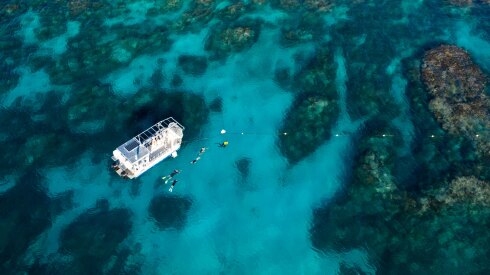The province of Bohol seems to encourage the bizarre. It contains one of the world’s strangest landscapes, a collection of some 1,700 hills in a 20-square-mile area called the Chocolate Hills. It is also home to a peculiar creature called the Philippine tarsier (locally referred to as the mawmag or mamag), one of the smallest known primates, no larger than an adult man’s hand, with giant round eyes and a tail that is longer than its body. These adorable beasts are spread across various islands in the southeast of the Philippines, surviving in rain forests with thick vegetation. They are nocturnal, can leap as far as 10 feet from tree to tree, and (like owls) are able to turn their heads 180 degrees. Unfortunately, habitat destruction via logging and mining threatens the Philippine tarsier with extinction. The best place in Bohol to see them and support their conservation at the same time is at the Philippine Tarsier and Wildlife Sanctuary in Corella. Run by the Philippine Tarsier Foundation, a nonprofit dedicated to tarsier conservation and education, this small but successful sanctuary provides the best possible environment to allow these tiny creatures to survive and thrive.
More Recommendations
Tarsier: The Philippines' Big-Eyed Primate in Bohol
The province of Bohol seems to encourage the bizarre. It contains one of the world’s strangest landscapes, a collection of some 1,700 hills in a 20-square-mile area called the Chocolate Hills. It is also home to a peculiar creature called the Philippine tarsier (locally referred to as the mawmag or mamag), one of the smallest known primates, no larger than an adult man’s hand, with giant round eyes and a tail that is longer than its body. These adorable beasts are spread across various islands in the southeast of the Philippines, surviving in rain forests with thick vegetation. They are nocturnal, can leap as far as 10 feet from tree to tree, and (like owls) are able to turn their heads 180 degrees. Unfortunately, habitat destruction via logging and mining threatens the Philippine tarsier with extinction. The best place in Bohol to see them and support their conservation at the same time is at the Philippine Tarsier and Wildlife Sanctuary in Corella. Run by the Philippine Tarsier Foundation, a nonprofit dedicated to tarsier conservation and education, this small but successful sanctuary provides the best possible environment to allow these tiny creatures to survive and thrive.
Wow, What Big Beautiful Eyes You Have!
Often mistakenly dubbed as the “world’s smallest monkey,” the Philippine Tarsier ranks as one of the smallest primates in the world. Closely related to lemurs, these shy, delicate creatures literally fit in the palm of your hand. This was taken at a viewing/feeding station along the Loboc River. The fun part was feeding them - get a cricket from a jar using a stick, place it in front of the tarsier, and watch them eat it whole!
8 year old female Philippine Tarsier
Philippine tarsiers, the wolrd’s smallest primate, are on the edge of endangerement in the Phillippines due to deforestation and illegal trade in exotic animals. This small, but successful sanctuary is the only place you can see them in their natural habitat. There are other “conservation” locations in the area, but they are essentially zoos. Tarsiers become depressed in enclosed spaces. They have even been known to commit suicide. In fact, a tarsier, which is small enough to fit in the palm of your hand, need a hectare of space to itself as it is primarily a solitary animal. They are nocturnal as well - their eyes are 150 times bigger than a humans in scale to the body. Your visit to this sanctuary helps support its efforts and helps spread education. At only 60PHP (they really shoudl charge more) its worth it. The tarsiers are SO DARN CUTE!







